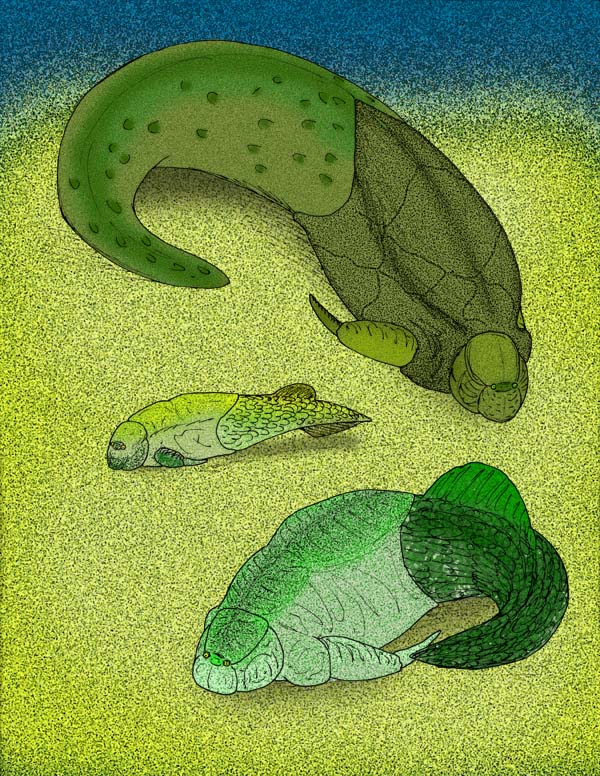|
Antiarchs
Antiarchi ("opposite anus") is an order of heavily armored placoderms. The antiarchs form the second-most successful group of placoderms after the arthrodires in terms of numbers of species and range of environments. The order's name was coined by Edward Drinker Cope, who, when examining some fossils that he thought were armored tunicates related to '' Chelyosoma'', mistakenly thought that the orbital fenestra (i.e., the hole in the headshield for the eyes, nose and pineal foramen) was the opening for the mouth, or oral siphon, and that the opening for the anal siphon was on the other side of the body, as opposed to having both oral and anal siphons together at one end. The front portions of their bodies were heavily armored, to the point of literally resembling a box with eyes, with the sometimes scaled, sometimes naked rear portions often becoming sinuous, particularly with later forms. The pair of pectoral fins were modified into a pair of caliper-like, or arthropod-like l ... [...More Info...] [...Related Items...] OR: [Wikipedia] [Google] [Baidu] |
Bothriolepis Canadensis
''Bothriolepis'' (from , 'trench' and 'scale') was a widespread, abundant and diverse genus of antiarch placoderms that lived during the Middle to Late Devonian period of the Paleozoic Era. Historically, ''Bothriolepis'' resided in an array of paleo-environments spread across every paleocontinent, including near shore marine and freshwater settings. Most species of ''Bothriolepis'' were characterized as relatively small, benthic, freshwater detritivores (organisms that obtain nutrients by consuming decomposing plant/animal material), averaging around in length. However, the largest species, ''B. rex'', had an estimated bodylength of . Although expansive with over 60 species found worldwide, comparatively ''Bothriolepis'' is not unusually more diverse than most modern bottom dwelling species around today. Classification ''Bothriolepis'' is a genus placed within the placoderm order Antiarchi. The earliest antiarch placoderms first appeared in the Silurian period of the Paleozo ... [...More Info...] [...Related Items...] OR: [Wikipedia] [Google] [Baidu] |
Bothriolepis
''Bothriolepis'' (from , 'trench' and 'scale') was a widespread, abundant and diverse genus of antiarch placoderms that lived during the Middle to Late Devonian period of the Paleozoic Era. Historically, ''Bothriolepis'' resided in an array of paleo-environments spread across every paleocontinent, including near shore marine and freshwater settings. Most species of ''Bothriolepis'' were characterized as relatively small, benthic, freshwater detritivores (organisms that obtain nutrients by consuming decomposing plant/animal material), averaging around in length. However, the largest species, ''B. rex'', had an estimated bodylength of . Although expansive with over 60 species found worldwide, comparatively ''Bothriolepis'' is not unusually more diverse than most modern bottom dwelling species around today. Classification ''Bothriolepis'' is a genus placed within the placoderm order Antiarchi. The earliest antiarch placoderms first appeared in the Silurian period of the Pal ... [...More Info...] [...Related Items...] OR: [Wikipedia] [Google] [Baidu] |
Ludfordian
In the geologic timescale, the Ludfordian is the upper of two chronostratigraphic stages within the Ludlow Series. Its age is the late Silurian Period, and within both the Palaeozoic Era and Phanerozoic Eon. The rocks assigned to the Ludfordian date to between 425.6 ± 0.9 Ma and 423.0 ± 2.3 Ma (million years ago). The Ludfordian Stage succeeds the Gorstian Stage and precedes the Pridoli Epoch. It is named for the village of Ludford in Shropshire, England. The GSSP for the Ludfordian is represented as a thin shale seam, coincident with the base of the Leintwardine Formation, overlying the Bringewood Formation in England. Paleoclimate The Lau event is a rapid pulse of cooling during the Ludfordian, about ; it is identified by a pulse of extinctions and oceanic changes. It is one of the series of fast sea-level and excursions in oxygen isotope ratios that signal fast switches between warm and cold climate states, characteristic of the Silurian climatic instability. T ... [...More Info...] [...Related Items...] OR: [Wikipedia] [Google] [Baidu] |
Cladogram
A cladogram (from Greek language, Greek ''clados'' "branch" and ''gramma'' "character") is a diagram used in cladistics to show relations among organisms. A cladogram is not, however, an Phylogenetic tree, evolutionary tree because it does not show how ancestors are related to descendants, nor does it show how much they have changed, so many differing evolutionary trees can be consistent with the same cladogram. A cladogram uses lines that branch off in different directions ending at a clade, a group of organisms with a last common ancestor. There are many shapes of cladograms but they all have lines that branch off from other lines. The lines can be traced back to where they branch off. These branching off points represent a hypothetical ancestor (not an actual entity) which can be inferred to exhibit the traits shared among the terminal taxa above it. This hypothetical ancestor might then provide clues about the order of evolution of various features, adaptation, and other e ... [...More Info...] [...Related Items...] OR: [Wikipedia] [Google] [Baidu] |
Bothriolepididae
Bothriolepididae is a family of antiarch placoderms, known from the Emsian, to Famennian. Taxonomy The cladogram is fromBothriolepid antiarchs (Vertebrata, Placodermi) from the Devonian of the north-western part of the East European Platform. {{Clade, style={{Clade , label1= Bothriolepidoidei , 1={{Clade , 1={{Clade , 1='' Microbrachius'' , 2='' Wudinolepis'' , 2={{Clade , 1={{Clade , 1='' Dianolepis'' , 2='' Jiangxilepis'' , 3='' Kirgisolepis'' , 4='' Tenizolepis'' , 2={{Clade , 1='' Monarolepis'' , 2={{Clade , 1=''Bothriolepis ''Bothriolepis'' (from , 'trench' and 'scale') was a widespread, abundant and diverse genus of antiarch placoderms that lived during the Middle to Late Devonian period of the Paleozoic Era. Historically, ''Bothriolepis'' resided in an array ...'' , 2='' Grossilepis'' , 3='' Vietnamaspis'' References { ... [...More Info...] [...Related Items...] OR: [Wikipedia] [Google] [Baidu] |


